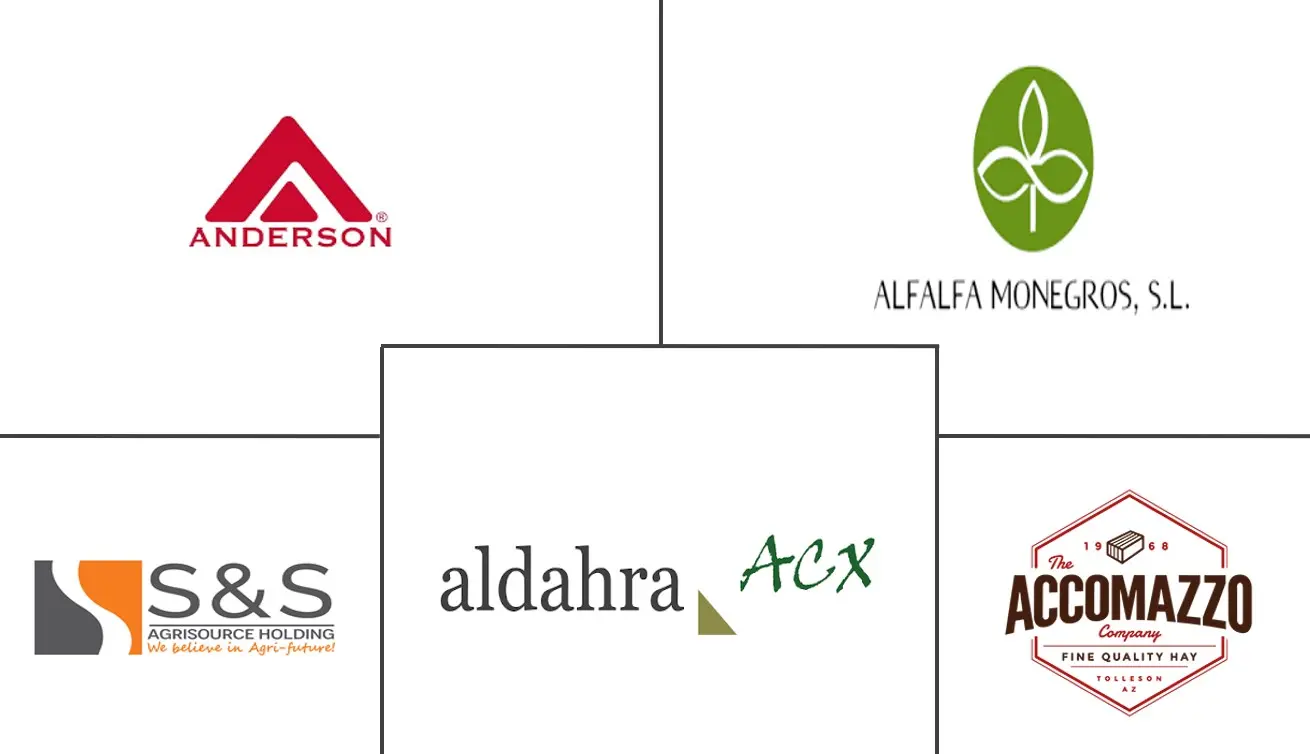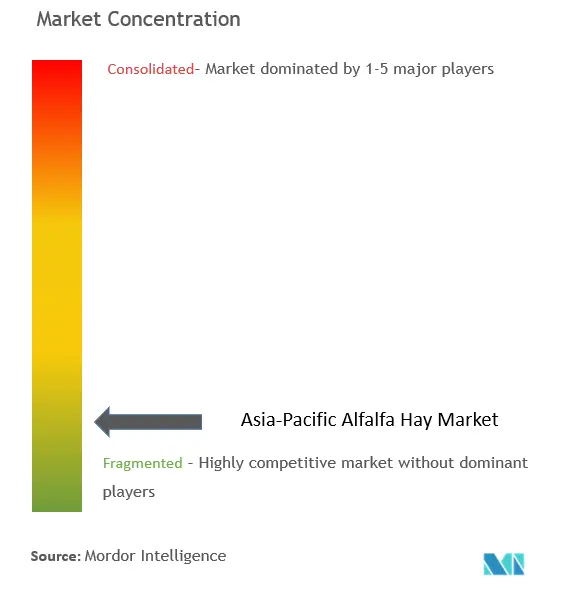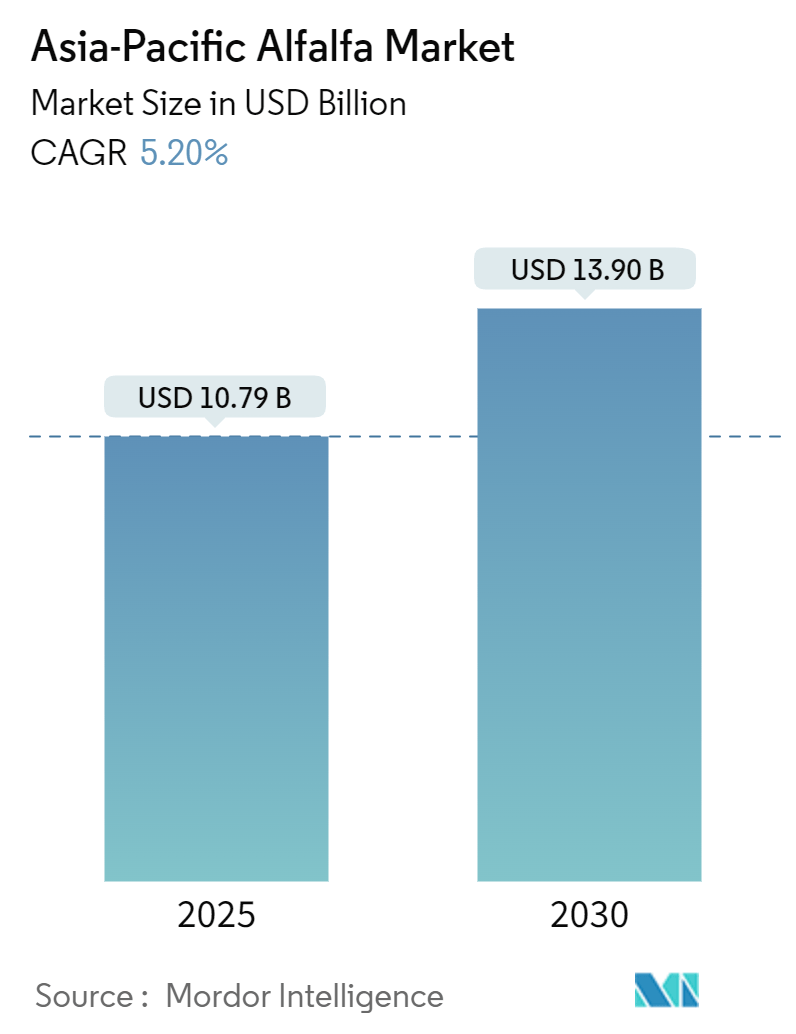
Asia-Pacific Alfalfa Market Analysis
The Asia-Pacific Alfalfa Market size is estimated at USD 10.79 billion in 2025, and is expected to reach USD 13.90 billion by 2030, at a CAGR of 5.20% during the forecast period (2025-2030).
Alfalfa hay has emerged as an essential component in dairy and poultry feed due to its high crude protein content. The Asia Pacific alfalfa hay market growth is primarily driven by its continued importance in animal feed applications. Modern practices in the dairy industry are propelling this regional market's expansion. Dairy farmers are not only increasing their herd sizes but are also turning to imported hay and commercial feeds. In response to this surging demand, governments are emphasizing the production of domestic alfalfa hay. As per USDA, India, in collaboration with the U.S., has set a target of USD 60 million in alfalfa hay exports by 2026.
In China, alfalfa thrives in the northern and western regions, notably Inner Mongolia, Xinjiang, and Gansu, where the climate and vast grasslands are conducive to its growth. While China's alfalfa exports have been modest, in 2023, the nation shipped out around 500,000 tons, primarily to neighboring countries and Southeast Asia.
Studies highlight that alfalfa hay not only boosts animal growth and development but also enhances milk productivity. Its rich protein and energy content make it a prized addition to the diets of lactating dairy cows. Furthermore, its rapid fermentation, diverse mineral profile, and fiber content play a crucial role in promoting rumen health and synthesizing milk butterfat. Such advantages have spurred the demand for alfalfa hay, especially in cattle and horse feed.
With diminishing grazing fields, alfalfa cultivation areas in the region are expanding. Farmers are ramping up alfalfa production to satisfy livestock feed needs. This surge in demand for nutritious legume-based forage crops has led to an increase in the harvested area for alfalfa. Given these dynamics, the Asia-Pacific alfalfa hay market is poised for continued growth in the coming years.
Asia-Pacific Alfalfa Market Trends
Increasing Demand for Meat Consumption Boosting Quality Hay Market
Rising Meat Consumption and Dairy Production Driving Asia-Pacific Alfalfa Hay Market. Meat consumption is driving the growth of the Asia-Pacific alfalfa hay market. The meat market's growth is primarily attributed to increasing demand for high-quality products. Lucerne alfalfa is a crucial hay crop in the region, with its quality significantly impacting livestock performance and profitability, particularly in dairy operations.
Livestock products remain essential sources of nutrition across the region. The consumption of animal products, including milk, cheese, and meat, continues to increase throughout Asia-Pacific. Asia-Pacific lucerne hay maintains a reputation for premium quality in international markets. The increasing demand for quality animal products drives the need for superior feed, boosting the alfalfa hay market as farmers select high-grade forage for their cattle.
The dairy industry's expansion is supported by the systematic adoption of technology, enabling efficient management of larger cattle herds for increased profitability. This trend is anticipated to increase demand for specialized forage seeds used in feed production, consequently driving the alfalfa hay market. The increasing demand for meat and related products, including processed burgers and sausages, shows significant growth potential in the food service sector. These factors like increased meat production, demand for quality livestock feed, and food service sector growth are driving alfalfa hay demand during the forecast period.
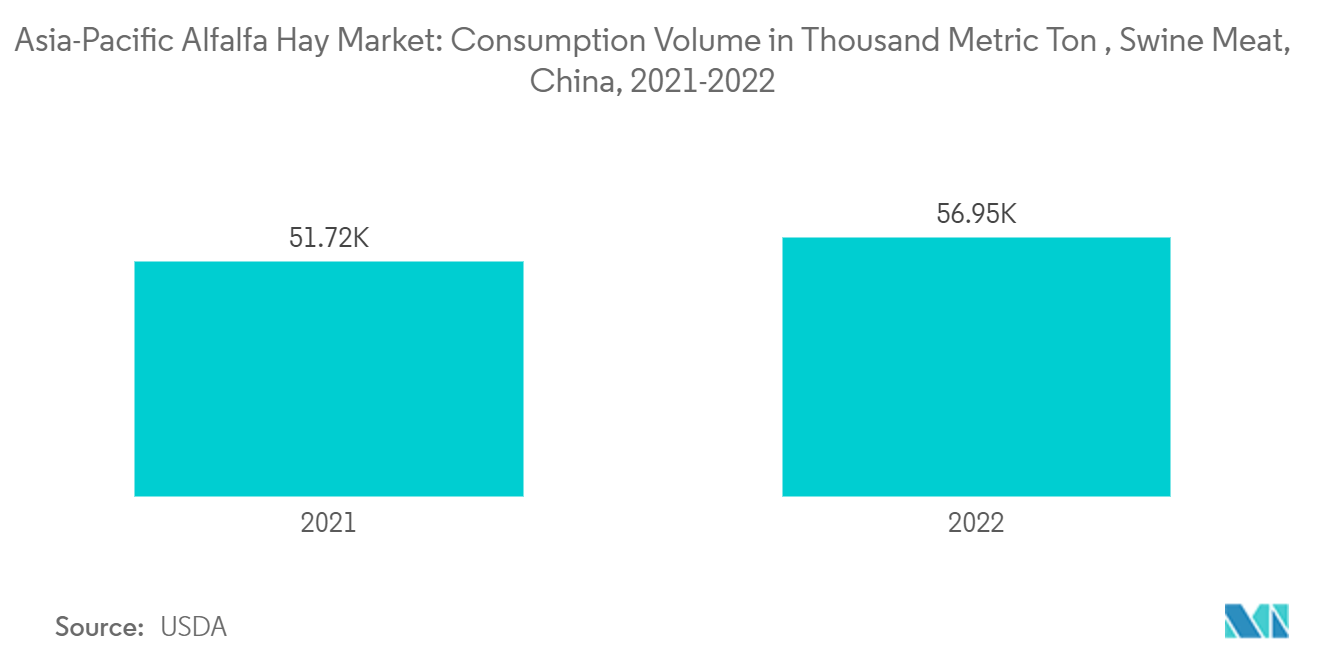
India Dominated the Market
The alfalfa market in India has been evolving rapidly, driven by increasing demand from the livestock industry, particularly for dairy production. Alfalfa, a highly nutritious legume forage, is crucial for improving the productivity of livestock such as dairy cattle, beef cattle, and other ruminants. In 2023, alfalfa production in India was done majorly in states like Rajasthan, Haryana, Punjab, and Madhya Pradesh. These states have favorable agro-climatic conditions for growing alfalfa, with areas receiving moderate rainfall and suitable soil for alfalfa cultivation. India is the world's largest milk producer, and its dairy industry plays a crucial role in the demand for alfalfa. This massive scale of milk production requires a large amount of high-quality feed, including alfalfa.
While domestic production of alfalfa is growing, India still imports a significant portion of its alfalfa from countries like the United States, Australia, and Argentina to meet the demand from its expanding livestock industry. As per ITC Trademap, India imported about 65.4 thousand metric tons of alfalfa in 2023. As India continues to modernize its agricultural practices, the demand for high-quality feeds like alfalfa is anticipated to increase, leading to continued growth in the alfalfa market
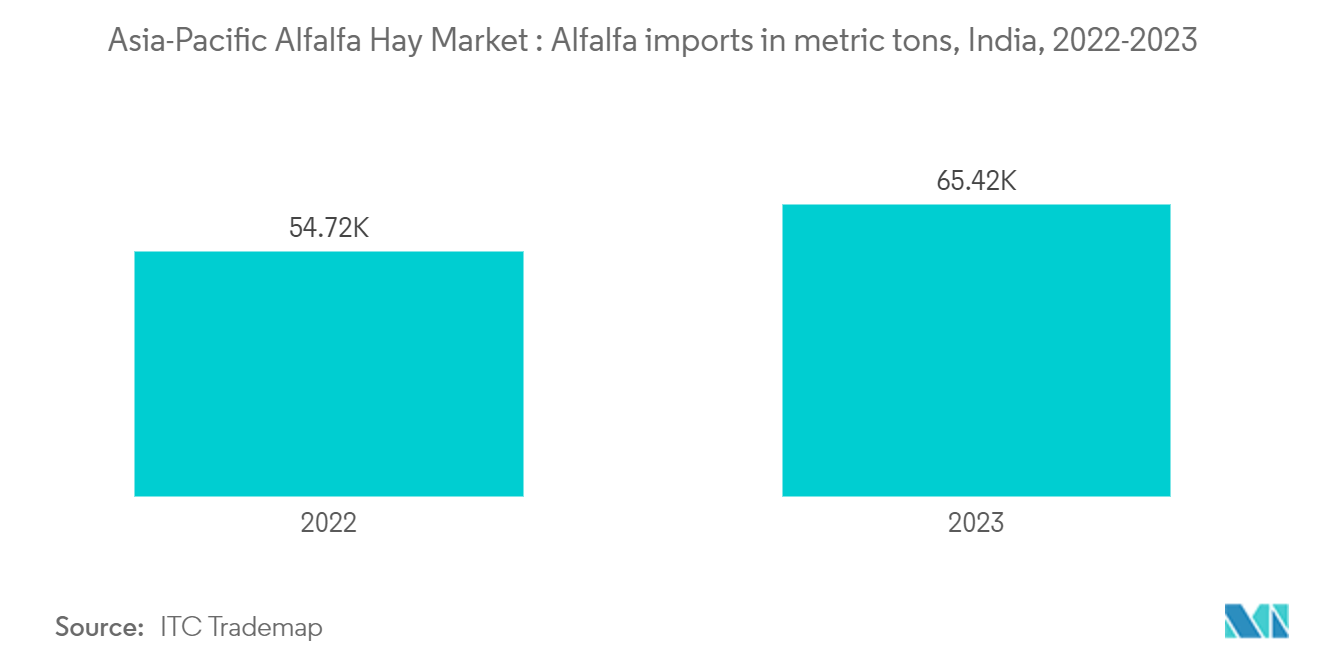
Asia-Pacific Alfalfa Industry Overview
The Asia-Pacific Alfalfa Hay Market is fragmented, with players such as Alfalfa Monegros, S.L., Anderson hay & grain co, S&S Agrisource Holding LLC, Al Dahra ACX Global, Inc, etc. The players are investing in improvisation of products, partnerships, expansions, and acquisitions for business expansions.
Asia-Pacific Alfalfa Market Leaders
-
Alfalfa Monegros, S.L.
-
Anderson hay & grain co
-
S&S Agrisource Holding LLC
-
Al Dahra ACX Global, Inc
-
The Accomazzo Company
- *Disclaimer: Major Players sorted in no particular order
Asia-Pacific Alfalfa Market News
- January 2023: As per the country's agriculture ministry, China granted GMO alfalfa import after a decade-long wait. This will help the country to serve the customers of alfalfa with premium quality alfalfa across the country.
- January 2022: In an announcement, India agreed to import products including alfalfa hay from the United States. The decision will positively impact the alfalfa market as well as the international relation between the two countries.
Asia-Pacific Alfalfa Industry Segmentation
Alfalfa hay is obtained from the alfalfa plant, which is also known as Lucerne and Medicago sativa. It is cultivated as an important forage crop in many countries worldwide. The Aisa-Pacific alfalfa hay market is segmented by type (bales, pellets, and cubes), by application (Meat/dairy animal feed, Poultry, Horse feed, and Other Applications), by geography (China, Japan, India, Australia, and Rest of Asia-Pacific). The report offers market size and forecasts in terms of value in USD million for all the above segments.
| Type | Bales |
| Pellets | |
| Cubes | |
| Application | Dairy animal feed |
| Poultry | |
| Horse feed | |
| Other Applications | |
| Geography | China |
| Japan | |
| India | |
| Australia | |
| Rest of Asia-Pacific |
Asia-Pacific Alfalfa Market Research FAQs
How big is the Asia-Pacific Alfalfa Market?
The Asia-Pacific Alfalfa Market size is expected to reach USD 10.79 billion in 2025 and grow at a CAGR of 5.20% to reach USD 13.90 billion by 2030.
What is the current Asia-Pacific Alfalfa Market size?
In 2025, the Asia-Pacific Alfalfa Market size is expected to reach USD 10.79 billion.
Who are the key players in Asia-Pacific Alfalfa Market?
Alfalfa Monegros, S.L., Anderson hay & grain co, S&S Agrisource Holding LLC, Al Dahra ACX Global, Inc and The Accomazzo Company are the major companies operating in the Asia-Pacific Alfalfa Market.
What years does this Asia-Pacific Alfalfa Market cover, and what was the market size in 2024?
In 2024, the Asia-Pacific Alfalfa Market size was estimated at USD 10.23 billion. The report covers the Asia-Pacific Alfalfa Market historical market size for years: 2019, 2020, 2021, 2022, 2023 and 2024. The report also forecasts the Asia-Pacific Alfalfa Market size for years: 2025, 2026, 2027, 2028, 2029 and 2030.
Our Best Selling Reports
Asia-Pacific Alfalfa Industry Report
Statistics for the 2025 Asia-Pacific Alfalfa market share, size and revenue growth rate, created by Mordor Intelligence™ Industry Reports. Asia-Pacific Alfalfa analysis includes a market forecast outlook for 2025 to 2030 and historical overview. Get a sample of this industry analysis as a free report PDF download.

